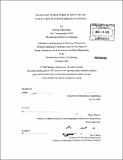Projection of fractures in ships for the evaluation of fatigue resistant designs
Author(s)
Hadjiyiannis, Nicholas
DownloadFull printable version (7.942Mb)
Other Contributors
Massachusetts Institute of Technology. Dept. of Mechanical Engineering.
Advisor
Henry Marcus.
Terms of use
Metadata
Show full item recordAbstract
Cracks in ships have been of great concern to the maritime industry for a very long time. The problem is controlled by improving design, minimizing operating stresses and through regular inspections and repairs. The big trade-off which designers and owners have to face in the construction of a new ship is whether to invest in a fatigue resistant design, or to keep the construction cost low and incur the repair costs as cracks emerge later in the ship's life. This choice has to be made for hundreds of components throughout the ship's hull. A procedure was developed to assess the cost effectiveness of fatigue design improvements in ships. It is based on comparing the additional cost of a proposed design (over the current design) with the present value of all the projected crack repair costs of the corresponding location. The present value of the repair costs has to be determined for the various locations in order to serve as a guideline when evaluating new fatigue resistant designs that promise to reduce the number of cracks and future repair costs. A general model was developed and then several assumptions were made to give a simplified version. The assumptions and limitations of the model are discussed as well as the ways in which it should be used to address various problems and produce meaningful results. Suggestions are also made for avoiding problems in each stage. A large database of cracks is required to run the model and a location coding system in order to process and analyze it.. (cont.) The difficulties of collecting and processing the data are discussed as well as potential adjustments that have to be made to accommodate irregularities among ships and ship compartments. A literature review was carried out of the various statistical surveys that have been conducted over the past 50 years relating to cracks and damages in ships. Differences in the results of surveys regarding the distribution of cracks lead to the conclusion that cracks follow different patterns than other damages and that the various kinds of ships exhibit different cracking behaviors. This emphasizes the importance of using a large data sample that is specific to a particular type of damage and ship type and size range when applying this proposed model and procedure.
Description
Thesis (S.M.)--Massachusetts Institute of Technology, Dept. of Mechanical Engineering, 2009. Cataloged from PDF version of thesis. Includes bibliographical references (p. 71-81).
Date issued
2009Department
Massachusetts Institute of Technology. Department of Mechanical EngineeringPublisher
Massachusetts Institute of Technology
Keywords
Mechanical Engineering.